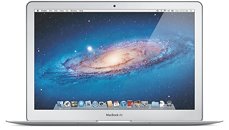Sunday, February 12th 2012

White MacBook Replaced With New 13-inch $999 MacBook Air for Educational Institutions
A little earlier this month, Apple discontinued supplies of its 13-inch white MacBook (base) to educational institutions, which it stopped selling to consumers much earlier, last year. Apple has replaced this education variant of white MacBook with a new education variant of MacBook Air. The new variant will be offered to educational institutions at US $999 a piece, when purchased in packs of 5 (costing US $4,995), making it a viable replacement to the white MacBook.
The new MacBook Air variant is also a 13-incher, driven by Intel Core i5 ULV processor clocked at 1.60 GHz, with 2 GB of DDR3 memory, 64 GB solid-state storage (carried on from the 11-inch consumer base model of MacBook Air), but features the larger 13-inch display. Unfortunately, this model is only available to educational institutions that purchase in bulk (those packs of 5), and so the cheapest MacBook individual students can buy is the 11-inch MacBook Air.
Source:
MacRumors
The new MacBook Air variant is also a 13-incher, driven by Intel Core i5 ULV processor clocked at 1.60 GHz, with 2 GB of DDR3 memory, 64 GB solid-state storage (carried on from the 11-inch consumer base model of MacBook Air), but features the larger 13-inch display. Unfortunately, this model is only available to educational institutions that purchase in bulk (those packs of 5), and so the cheapest MacBook individual students can buy is the 11-inch MacBook Air.

18 Comments on White MacBook Replaced With New 13-inch $999 MacBook Air for Educational Institutions
As far as quality goes. Varies. Some generations are better than the other. It is the same with PCs. Apple constantly moving towards smaller and more compact designs has made them more eye appealing, but I do feel they've lost a bit of strength.
lol I remember when Apple used to advertise about their case strength. Talks about titanium and bulletproof materials. They've really cheapened out, and done it while keeping the prices high.
I'd consider some PCs the same. After I took apart an HP a few months back, I decided I would never want one. Terribly shoddy build. Others I've felt, feel like mostly all cheap plastic. I know how those end up, cracked and in dumpsters.
EDIT: And i don't care if they made even a little cheaper than that they still $500 over what they should cost regardless to what OS they have on them. We just picked up a ASUS one with accidental coverage by default for $400
For example, I have an acquaintance who is doing 3 years of photography and feels it is unreasonable for him to buy a Mac for his home based of the sheer fact he has to work with them at school, but almost feels forced to due to the way he is taught to use the Adobe software on a Mac feels different to making the same functions work on a PC.
State/district schools are doing the more sensible thing, and buying Chromebooks from Google.
No, it wasn't a rich uppity town either, just a small public school system. We only had a single admin for 400-500 machines. It could not be done as effectively by a single person with windows. Just not possible.
Windows licensing also raised price flags, and Apple networks ended up being significantly cheaper in the long run;
-Batteries were always easy to aquire, consistent over the course of the 4 years I was there (then they began the intel transition, but the power adaptors are still generally consistent.)
-Net imaging was very very easy, (This was in the 98/2000/XP days, where windows could barely even stand being networked.)
-Remote administration with active directory is insanely easy compared to windows for managing users in a school district.
-individual device security was possible; the entire network doesn't require extra bullshit licenses to things like deepfreeze to insure users don't mess up their systems, causing inconveniences for not only the instructors, but huge headaches as system administrators trying to recover data the instructor foolishly stored locally.
-Antivirus was run on the domain server, and not necessary anywhere else. Yet another HUGE cost savings.
-Application consistency: Restoring a device from image doesn't require a fancy slip streamed windows image, and if a device didn't have a program locally, it could easily be pulled from the AD server to be accessible to the user. NOT easily done with windows.
-OS Consistency; again with application integration, OS integration doesn't require a separate image for every slightly different machine. One OS X fits all.
Overall, as a school on a tight budget, and especially with short personnel to actually handle the supporting tasks, Apple provides an amazing network for educational systems. Chromebooks offer similar WAN considerations. The key here, really, is NOT using windows.
Just no. :roll:
edit: also sorry for the delay, i'm in afghanistan >.>